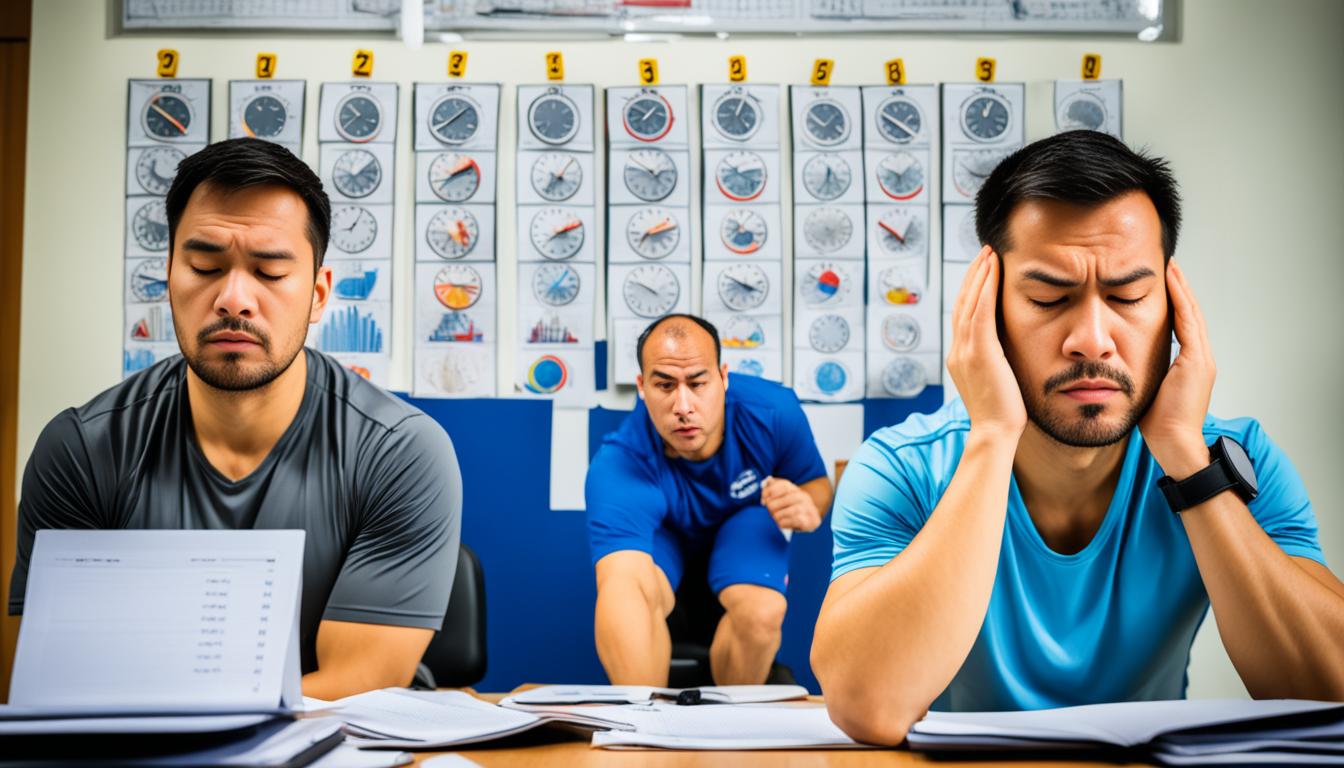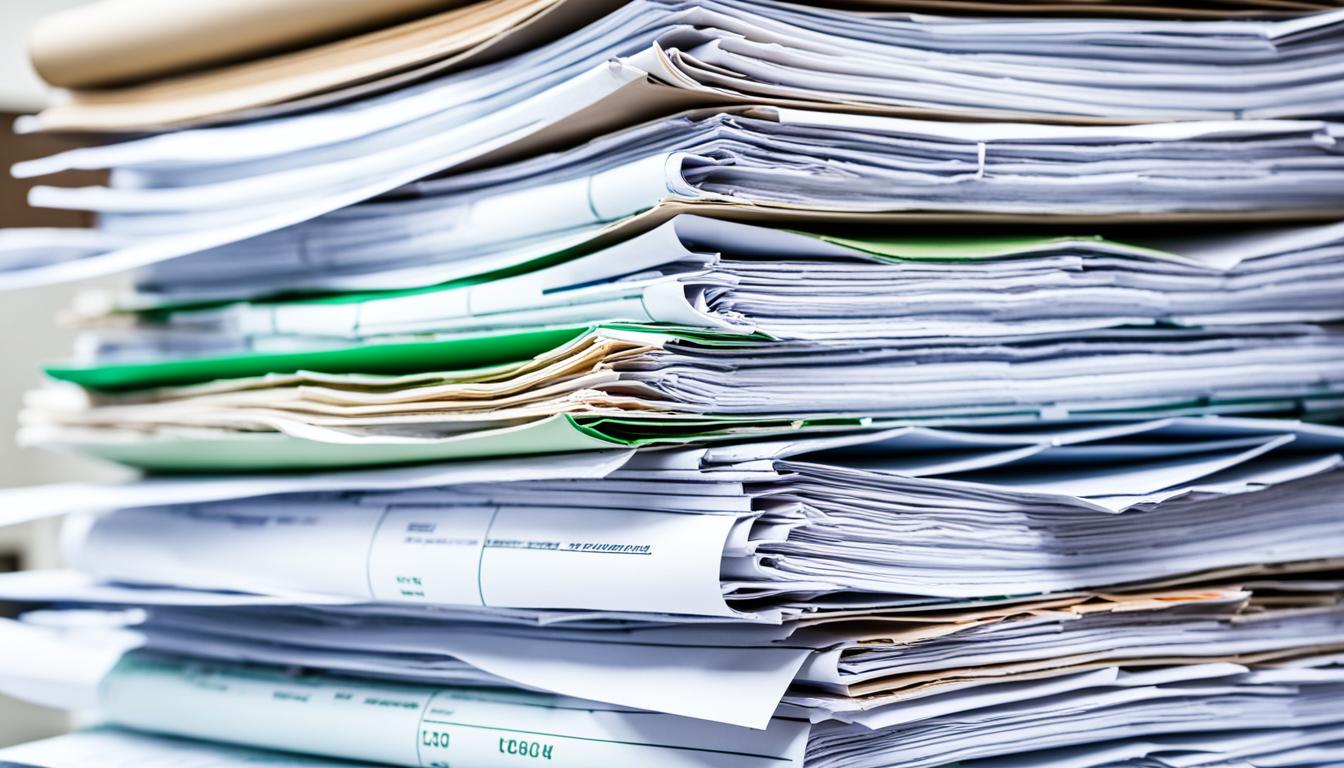Do you ever feel overwhelmed and stressed when faced with tight deadlines and high-pressure situations at work? Are you searching for effective strategies to handle the demands of a fast-paced work environment while staying calm and composed? Look no further. In this article, we will explore valuable tips and techniques for working under pressure and managing stress effectively.
Key Takeaways
- Understand the impact of work-induced stress on performance
- Build resilience to maintain high productivity
- Discover techniques for staying calm under pressure
- Embrace challenges as opportunities
- Craft a strategic approach to planning and executing under stress
The Nature of Work-Induced Stress and Its Impact on Performance
Work-induced stress is a common occurrence in the modern workplace, affecting individuals at all levels of an organization. It can arise from various factors such as tight deadlines, heavy workloads, interpersonal conflicts, and high expectations. The pressure to meet targets and deliver results often leads to increased stress levels among employees, affecting their overall well-being and performance.
Understanding Stress in Philippine SME Workplaces
In the context of the Philippines, small and medium-sized enterprises (SMEs) are the backbone of the economy, with a significant portion of the workforce employed in these organizations. However, the fast-paced nature of SMEs, combined with limited resources and high expectations, can contribute to elevated levels of workplace stress. It is crucial to understand the unique challenges faced by employees in Philippine SME workplaces to effectively address and alleviate work-induced stress.
Consequences of Excessive Pressure on Team Productivity
Excessive pressure and stress can have detrimental effects on team productivity. When individuals are overwhelmed by stress, their ability to concentrate, make decisions, and collaborate effectively can be significantly impaired. This can result in decreased productivity, missed deadlines, and a decline in the quality of work. It is essential for organizations to recognize the negative impact of work-induced stress on team performance and take proactive measures to mitigate its effects.
Building Resilience to Maintain High Performance
To thrive in high-pressure environments, it is crucial for individuals to develop resilience. Resilience is the ability to bounce back from adversity, adapt to change, and maintain high performance in the face of challenges. By building resilience, employees can better cope with work-induced stress, effectively manage their emotions, and maintain productivity even in demanding situations. Organizations can support the development of resilience through training programs, fostering a supportive work culture, and providing resources for stress management.
Maintaining Control: Techniques for Staying Calm Under Pressure
In the fast-paced and demanding world of work, it is crucial to maintain control and stay calm under pressure. The ability to remain composed and manage stress effectively is essential for personal well-being and professional success. In this section, we will explore practical techniques for maintaining control under pressure and coping with work-related stress.
1. Maintain control of the situation: When faced with a high-pressure situation, it is important to stay in control of your emotions and actions. Take a moment to assess the situation objectively and devise a plan of action. This will help you approach the situation with a clear mind and make well-informed decisions.
2. Manage negative thoughts: Negative thoughts and self-doubt can significantly impact your ability to stay calm under pressure. Practice positive self-talk and challenge negative thinking patterns. Remind yourself of your past successes and strengths to build confidence and reduce anxiety.
3. Eliminate distractions: Distractions can hinder your ability to focus and maintain control. Create a conducive work environment by minimizing distractions such as noise, clutter, and interruptions. Prioritize your tasks and allocate dedicated time to focus on important projects.
4. Practice concentration techniques: Sharpening your concentration skills can help you stay focused and composed under pressure. Techniques such as deep breathing exercises, meditation, and mindfulness can improve your ability to stay present and maintain control in high-stress situations.
By implementing these stress management techniques and staying calm under pressure, you can enhance your productivity, make better decisions, and foster a healthier work environment. Remember, maintaining control is not about avoiding or suppressing stress, but rather managing it effectively to thrive in challenging situations.
How Do You Work Under Pressure: Embracing Challenges as Opportunities
When faced with high-pressure situations at work, it is crucial to adopt a positive attitude and mindset. Embracing challenges as opportunities can not only help you navigate through stressful circumstances but also enable personal and professional growth. By adjusting your attitudes towards high-pressure situations, you can effectively manage stress and enhance your work efficiency.
Adjusting Attitudes Towards High-Pressure Situations
One way to embrace challenges is by reframing your perspective on high-pressure situations. Instead of viewing them as overwhelming obstacles, consider them as opportunities for growth and development. Recognize that working under pressure provides valuable learning experiences and a chance to showcase your capabilities. By shifting your mindset and seeing challenges as stepping stones to success, you can approach them with confidence and determination.
Embracing challenges also involves cultivating a positive attitude under stress. Maintain a hopeful and optimistic outlook, even when faced with difficult tasks or tight deadlines. By focusing on the possibilities and potential solutions rather than dwelling on stress and negativity, you can overcome obstacles more effectively.
Prioritizing Tasks to Enhance Work Efficiency
Task prioritization is crucial when working under pressure. By organizing your work based on urgency and importance, you can enhance your work efficiency and productivity. Begin by identifying the most critical tasks and deadlines, and tackle them first. Prioritizing tasks allows you to allocate your time and energy effectively, ensuring that important assignments are completed with the necessary attention and focus.
Consider using time management techniques such as the Eisenhower Matrix or the Pomodoro Technique to help prioritize and manage your workload. The Eisenhower Matrix categorizes tasks into four quadrants based on their urgency and importance, enabling you to focus on tasks that align with your goals and deliver the most significant impact. The Pomodoro Technique involves working in focused intervals, typically 25 minutes, followed by short breaks. This method helps maintain productivity and prevents burnout.
Additionally, learn to delegate non-essential tasks when appropriate. By entrusting certain responsibilities to capable colleagues or outsourcing certain aspects, you can free up time for more critical tasks and alleviate some of the pressure on yourself.
By embracing challenges as opportunities and adjusting your attitudes towards high-pressure situations, you can navigate through work-induced stress with resilience. Prioritizing tasks effectively enhances your work efficiency and allows you to maintain a positive attitude even under pressure. Embracing challenges and managing stress can ultimately lead to personal and professional growth, helping you thrive in demanding work environments.
Crafting a Strategic Approach: Planning and Executing Under Stress
When faced with work pressure and high-stress situations, having a strategic approach is crucial for maintaining productivity and making effective decisions. By planning and executing under stress, professionals can navigate challenging circumstances with confidence and achieve favorable outcomes.
To develop a strategic approach under stress, consider the following techniques:
- Set clear objectives: Start by identifying the desired outcome and breaking it down into actionable steps. This will help prioritize tasks and stay focused amidst pressure.
- Create a timeline: Establishing a timeline allows for better time management and ensures important tasks are completed within deadlines. It provides a sense of structure and helps manage stress.
- Delegate effectively: When under pressure, it’s important to delegate tasks to capable team members to lighten the load and ensure optimal results. Effective delegation helps distribute responsibilities and fosters collaboration.
- Practice effective decision-making: High-pressure situations require quick and effective decision-making. Evaluate available options, consider potential consequences, and make informed choices to navigate challenges successfully.
- Stay flexible: Adaptability is key when working under stress. Stay open to adjusting plans and strategies as new information becomes available. Being flexible allows for agility and effective problem-solving.
Remember, working strategically under pressure involves effective planning, efficient execution, and adaptive decision-making. By implementing these strategies, professionals can thrive in high-stress environments and achieve optimal results.
| Benefits of a Strategic Approach to Work Under Stress | Challenges Addressed |
|---|---|
| Enhanced productivity and efficiency | Difficulty in managing multiple tasks simultaneously |
| Improved problem-solving and decision-making | Pressure to make quick decisions under tight deadlines |
| Reduced stress levels and better work-life balance | Overwhelming workload and work-induced stress |
| Increased adaptability and resilience | Handling unexpected changes and setbacks |
Procrastination vs. Productivity: Balancing Workloads and Deadlines
When facing work-induced stress and tight deadlines, the battle between procrastination and productivity can become all too real. Procrastination, the act of delaying or avoiding tasks, hinders our ability to meet deadlines and achieve optimal productivity. However, with effective strategies and task management techniques, we can overcome procrastination and stay on track towards meeting our goals.
Recognizing Procrastination Triggers and Solutions
Identifying the triggers that lead to procrastination is the first step towards addressing this challenge. Common triggers include fear of failure, overwhelming workloads, lack of motivation, and perfectionism. By recognizing these triggers, we can develop personalized solutions to overcome them.
“Procrastination is like a credit card: it’s a lot of fun until you get the bill.” – Christopher Parker
One effective solution is to break tasks into smaller, more manageable chunks. By doing this, we can tackle each task incrementally, reducing the feeling of overwhelm and making it easier to get started. Additionally, creating a detailed schedule with specific deadlines for each task can provide a sense of accountability and structure, helping to combat procrastination tendencies.
Another valuable strategy is to eliminate distractions. This can be achieved by creating a designated workspace, turning off notifications on electronic devices, and using productivity tools or apps to block access to distracting websites or apps during work sessions.
Setting Mini-Deadlines for Optimal Task Management
Setting mini-deadlines throughout the project timeline can significantly improve task management and enhance productivity. Breaking down larger tasks into smaller milestones with specific deadlines helps maintain focus and prevents procrastination. These mini-deadlines serve as checkpoints, ensuring progress is made consistently toward the completion of larger goals.
Furthermore, incorporating the Pomodoro Technique, a time management method that involves working in focused bursts of 25 minutes followed by short breaks, can be instrumental in maximizing productivity. This technique helps maintain motivation and concentration, preventing burnout and minimizing the chances of succumbing to procrastination.
By employing these strategies and embracing a proactive mindset, we can successfully navigate the challenges of balancing workloads and meeting deadlines, ultimately enhancing our productivity and achieving greater success.
Pressure Handling Skills: Communication and Team Dynamics
When working under pressure, effective communication and strong teamwork are essential for success. In high-pressure environments, the ability to handle pressure and maintain effective collaboration can greatly impact team performance. In this section, we will explore the importance of building clear communication pathways with your team and discuss strategies for collaborating effectively in high-pressure environments.
Building Clear Communication Pathways with Your Team
Clear and open communication is key to navigating high-pressure situations with your team. By establishing clear channels of communication, team members can exchange information efficiently, align goals, and make informed decisions. Here are some strategies to build clear communication pathways:
- Establish regular team meetings or check-ins to discuss progress, challenges, and updates.
- Encourage open and honest communication, creating a safe space for team members to express their ideas, concerns, and suggestions.
- Utilize various communication tools and technologies, such as instant messaging platforms or project management software, to streamline communication and ensure everyone is on the same page.
- Clarify roles and responsibilities to avoid confusion and minimize miscommunication.
By fostering clear communication pathways, team members can effectively share information, resolve issues, and make timely decisions, even in the most high-pressure situations.
Collaborating Effectively in High-Pressure Environments
In high-pressure environments, effective collaboration is crucial for achieving desired outcomes and maintaining team morale. Here are some strategies to enhance collaboration under stress:
- Encourage a team-oriented mindset, where individual success is aligned with the team’s overall goals and objectives.
- Practice active listening to ensure everyone’s perspectives and ideas are heard and considered.
- Break down complex tasks into smaller, manageable parts and assign responsibilities based on team members’ strengths and expertise.
- Promote a supportive and inclusive team culture, where constructive feedback is encouraged and celebrated.
- Establish a sense of shared accountability, where each team member takes ownership of their tasks and contributes to overall success.
By collaborating effectively, teams can harness their collective skills and strengths to overcome challenges, adapt to high-pressure situations, and achieve optimal results.
Effective communication and teamwork are essential pressure handling skills in any high-pressure environment. By building clear communication pathways and collaborating effectively, teams can navigate challenging situations, maintain productivity, and achieve success.
Stress Relief Methods: Integrating Relaxation and Mindfulness into Your Workday
Work-induced stress can have detrimental effects on your overall well-being and productivity. It’s essential to incorporate stress relief methods into your daily routine to maintain a healthy work-life balance and effectively manage stress. In this section, we will explore relaxation techniques and mindfulness practices that can be integrated into your workday, promoting a sense of calm and enhancing your overall well-being.
To start, one effective stress relief method is to engage in relaxation techniques such as deep breathing exercises, progressive muscle relaxation, and guided imagery. These techniques can be done at your desk or in a quiet space, helping to reduce physical and mental tension.
Do you feel like a clock is ticking so fast that it’s nearly impossible to catch your breath in this fast-paced world? We live in a world so packed with work and everything else moving at such a fast pace that it is difficult to find time to relax.
Sometimes you are so busy with work-life stress and deadlines to meet that you forget to relax! Relaxing for just five minutes periodically by stepping away from what is causing your stress levels to rise can provide you with the energy to tackle your workload.
Leisure time today has become more of a luxury than a necessity. It is important to remember to relax in this hustle culture to help you recharge and rejoin the ground with an even more fresh mind.
This article will explore some motivating relaxation quotes to help you hit your goals with a more recharged mind.
Why Is Relaxing Important For Good Health?
“Sometimes the most productive thing you can do is relax.” – Mark Black
Mindfulness practices can also play a significant role in managing stress at work. Practicing mindfulness involves being fully present and aware of your thoughts, emotions, and surroundings. This practice allows you to focus on the present moment, reducing anxiety and promoting a sense of calmness.
Here are some simple ways to incorporate mindfulness into your workday:
- Take short mindfulness breaks. Set aside a few minutes each day to engage in mindful breathing or a quick meditation session.
- Practice gratitude. Take a moment to reflect on and appreciate the positive aspects of your work and surroundings.
- Stay in the present moment. Avoid multitasking and focus on one task at a time, giving it your full attention.
Additionally, creating a serene workspace can contribute to stress reduction. Incorporate elements such as plants, soft lighting, and calming colors to create a soothing environment.
By integrating relaxation techniques and mindfulness practices into your workday, you can effectively manage stress, improve your overall well-being, and achieve a healthier work-life balance. Taking the time to prioritize self-care will empower you to work under pressure with a clear and focused mind.
Strategies for Managing Pressure from Filipino Culture and Business Practices
In the Filipino workplace, managing pressure is crucial for maintaining productivity and work-life balance. The unique challenges and opportunities faced by individuals working in the Philippines require specific strategies for effective stress management. By understanding Filipino work culture and implementing targeted approaches, individuals can cope with work pressure more effectively.
1. Embrace the Bayanihan spirit
The Bayanihan spirit, a core value in Filipino culture, emphasizes community and unity. In the workplace, fostering a sense of camaraderie and support among colleagues can alleviate individual stress. Encouraging teamwork and collaboration creates a supportive environment where challenges are shared, and pressure is minimized.
2. Prioritize work-life balance
In the Philippines, work-life balance is highly valued. Incorporating leisure time, family activities, and personal hobbies into daily routines helps alleviate work-related stress. Employers can promote work-life balance by implementing flexible schedules, allowing employees to manage their time effectively.
3. Foster open communication
Effective communication is key to managing pressure in Filipino workplaces. Encouraging open dialogue between team members and superiors creates a supportive environment where concerns can be addressed. Clear communication channels foster understanding, reduce misunderstandings, and minimize stress levels.
4. Encourage self-care practices
Promoting self-care practices is vital for managing work pressure in the Philippines. Encouraging employees to engage in activities that promote physical and mental well-being, such as exercise, meditation, and hobbies, can help reduce stress levels. Providing resources and support for stress management workshops and seminars further enhances employees’ ability to cope with work pressure.
5. Implement flexible work arrangements
Flexible work arrangements, such as remote work options or flexitime, can help employees manage work pressure more effectively. Allowing individuals to choose when and where they work provides autonomy and reduces the stress associated with rigid schedules. By accommodating personal circumstances and preferences, employers can contribute to a more balanced and less pressured work environment.
6. Provide leadership support
Leadership plays a crucial role in managing pressure in the Filipino workplace. By demonstrating empathy, understanding, and support, leaders can create a positive work culture that promotes mental well-being. Providing resources for stress management, recognizing achievements, and offering guidance during challenging times all contribute to a more resilient team.
7. Encourage continuous learning
Continuous learning and professional development opportunities help individuals build the skills necessary to handle work pressure effectively. By investing in training and skill enhancement programs, employers empower their workforce to navigate challenging situations with confidence and competence.
8. Foster a positive work environment
A positive work environment promotes mental well-being and reduces stress levels. Recognizing accomplishments, providing feedback, and creating opportunities for growth and advancement all contribute to a positive workplace culture. By nurturing positivity and gratitude, individuals can better cope with work pressure in the Filipino context.
By implementing these strategies, individuals working in the Philippines can effectively manage pressure in the workplace. Building resilience, fostering support networks, and prioritizing work-life balance contribute to a healthier and more productive work environment.
Conclusion
Throughout this article, we have explored various strategies and techniques for coping with workplace pressure. We have discussed the impact of stress on performance and the importance of resilience in maintaining productivity. Additionally, we have provided practical tips for staying calm under pressure, embracing challenges as opportunities, and crafting a strategic approach to work.
Key takeaways include the significance of adjusting attitudes towards high-pressure situations and prioritizing tasks to enhance efficiency. We have also highlighted the importance of effective planning, decision-making, and overcoming procrastination to meet deadlines successfully. Additionally, we have emphasized the crucial role of clear communication and effective collaboration in high-pressure environments.
As we conclude, it is essential to acknowledge the role of leadership in alleviating stress for the team and fostering a supportive work environment. By emphasizing open communication, providing resources for stress relief, and promoting work-life balance, leaders can create a positive atmosphere that helps employees effectively cope with workplace pressure.
FAQ
How do you work under pressure?
Working under pressure can be challenging, but there are strategies you can use to effectively manage stress. Some tips for working under pressure include staying organized, prioritizing tasks, taking breaks to recharge, and seeking support from your team or supervisor.
What are some stress management techniques for handling pressure at work?
There are several stress management techniques that can help you handle pressure at work. These include deep breathing exercises, practicing mindfulness or meditation, engaging in physical activity, maintaining a healthy work-life balance, and seeking professional help if needed.
How can I stay calm under pressure?
Staying calm under pressure requires developing coping strategies. Some techniques you can use include taking deep breaths, reframing negative thoughts, focusing on the present moment, practicing time management, and using relaxation techniques such as visualization or progressive muscle relaxation.
What are some strategies for managing pressure?
Strategies for managing pressure include setting realistic goals, breaking tasks into smaller, manageable steps, delegating tasks when possible, maintaining open communication with your team, and seeking feedback and support when needed. Additionally, developing strong time management skills and maintaining a positive mindset can also help you effectively manage pressure.
How can I cope with pressure at work?
Coping with pressure at work involves developing techniques to manage stress and maintain productivity. Some effective coping strategies include setting boundaries, practicing self-care, seeking social support, maintaining a healthy work-life balance, and engaging in activities that help you relax and recharge.
What are some stress relief methods for managing pressure?
There are various stress relief methods you can try to manage pressure at work. These include engaging in physical exercise, taking regular breaks, practicing relaxation techniques like deep breathing or yoga, listening to calming music, and engaging in hobbies or activities that bring you joy and help you unwind.
How can I handle pressure at work effectively?
Handling pressure at work effectively involves developing strong time management skills, maintaining clear communication with colleagues and supervisors, prioritizing tasks, setting realistic goals, and being adaptable in the face of challenges. It’s also important to take care of your physical and mental well-being by practicing self-care habits and seeking support when needed.
How can I perform well under pressure?
To perform well under pressure, it’s essential to prepare in advance, stay focused on the task at hand, manage your time effectively, maintain a positive mindset, and utilize stress management techniques to stay calm and composed. Additionally, seeking feedback and learning from past experiences can help you improve your performance in high-pressure situations.
What are some stress management strategies for handling pressure in Filipino workplaces?
Stress management strategies for handling pressure in Filipino workplaces include fostering open communication, building strong relationships within your team, implementing work-life balance practices, recognizing cultural influences on work-related stress, and seeking support from mentors or counseling services.
What are some effective stress relief methods that I can integrate into my workday?
You can integrate stress relief methods into your workday by practicing mindfulness exercises, taking short breaks for stretching or deep breathing, listening to calming music, setting boundaries to manage your workload, and engaging in relaxation techniques like progressive muscle relaxation or guided imagery.
How can I manage pressure and stress more effectively in the context of Filipino culture and business practices?
Managing pressure and stress effectively in the context of Filipino culture and business practices involves understanding the cultural influences on work-related stress, building strong support networks within your workplace, recognizing the value of work-life balance, and incorporating stress management strategies that align with Filipino cultural norms and values.





